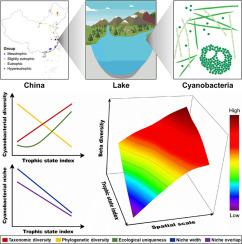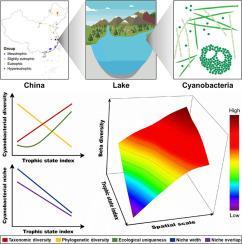Eutrophication increases the similarity of cyanobacterial community features in lakes and reservoirs
Abstract
Eutrophication of inland waters is a mostly anthropogenic phenomenon impacting aquatic biodiversity worldwide, and might change biotic community structure and ecosystem functions. However, little is known about the patterns of cyanobacterial community variations and changes both on alpha and beta diversity levels in response to eutrophication. Here, we investigated cyanobacterial communities sampled at 140 sites from 59 lakes and reservoirs along a strong eutrophication gradient in eastern China through using CPC-IGS and 16S rRNA gene amplicon sequencing. We found that taxonomic diversity increased, but phylogenetic diversity decreased significantly along the eutrophication gradient. Both niche width and niche overlap of cyanobacteria significantly decreased from low- to high-nutrient waterbodies. Cyanobacterial community distance-decay relationship became weaker from mesotrophic to hypereutrophic waterbodies, while ecological uniqueness (i.e., local contributions to beta diversity) tended to increase in high-nutrient waterbodies. Latitude and longitude were more important in shaping cyanobacterial community structure than other environmental variables. These findings suggest that eutrophication affects alpha and beta diversity of cyanobacterial communities, leading to increasingly similar community structures in lakes and reservoirs with a higher level of eutrophication. Our work highlights how cyanobacterial communities respond to anthropogenic eutrophication and calls for an urgent need to develop conservation and management strategies to control lake eutrophication and protect freshwater biodiversity.



 求助内容:
求助内容: 应助结果提醒方式:
应助结果提醒方式:


